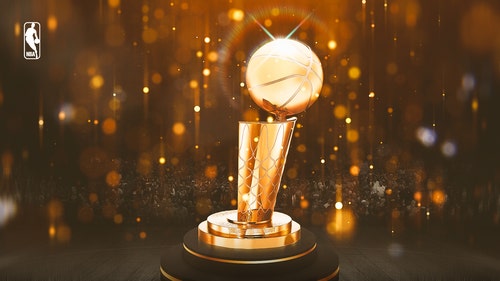
The Brad Stevens plan: How a coach reversed course for a franchise
Danny Ainge had a plan, but Brad Stevens is ruining it.
The Boston Celtics general manager was going to compile every draft pick known to mankind (Boston could own up to 10 first-rounders over the next four years), lose for a few seasons to boost the value of his own team's selections all while picking up low-risk, high-reward youth that could contribute down the line. But this team has put a dent in Ainge's idea — or maybe advanced it.
Even with all the midseason moves Ainge made — trading Rajon Rondo, Jeff Green, Brandan Wright, Marcus Thornton and waiving others — the 36-42 Celtics have shot all the way to seventh in the East, tied with the Brooklyn Nets and one game up on the ninth-place Indiana Pacers. The Celtics may not have anyone you want on your fantasy team, but they're 16-9 over their past 25 contests. How did they get there?
It began two years ago when Ainge hired Stevens.

Danny Ainge shocked a lot of people when he nabbed Stevens away from Butler.
Stevens rightfully earned the title of "overachiever" long ago, years before he entered the pros. You remember it. We all do. Matt Howard certainly does, even if you don't remember him.
"My time at Butler helped me in every regard," Stevens said. "We always talked about putting our strengths together and seeing how far we could go."
The former Butler coach led his small-time university in basketball-centric Indiana to back-to-back national championship games in 2010 and 2011, gaining notoriety for his baby face and analytical mind. Many marveled at Stevens' ability to retain and deploy statistical information. He was taking advanced stats, often unmined in the collegiate game, and using them to find an advantage.
Here's a photo of the after-timeout playcall by Brad Stevens. Unique plays like this are why he is a creative genius. pic.twitter.com/zcNz2MA4Vk
— Kevin O'Connor (@KevinOConnorNBA) April 5, 2015
By age 36, he was parsing out those numbers in the NBA, and feeding bits of them to players.
"He tells us this guy likes to go left or shoots this percentage from the corner or another spot, so that helps our game plan," said second-year point guard Phil Pressey. "A lot of things, though, he keeps to himself. He shares with us what needs to be shared with us."
That's Stevens, though: quiet, unassuming, giving away enough to teach without divulging too much to confuse.
Applying statistics in unique ways can help find market inefficiencies. Stevens, in the most Popovichian ways possible, unraveled how to accentuate the pure positive in players who are 60 percent bad, 40 percent good. He did it at Butler, though he will be the first to tell you that the collegians he led were far more impressive than their recruit rankings would have you believe. Now, he's doing it again in Boston.
"I think our job, when someone walks through our door for the first time is to focus on what they can do well and try to get the most out of them, and tell them we believe in what they do well," he said.
Evan Turner has grown this year, especially of late. Marcus Smart's defense has always exuded ferocity, but he's now added vast intelligence to the bit, a horrifying combination for any opposing player. Jae Crowder fits. Isaiah Thomas fits. Kelly Olynyk fits.
"Fits." It's an interesting depiction of this team, because the puzzle wasn't actually supposed to piece together. In reality, this was a squad of shapes from different puzzles. Stevens has hardly turned it into a Van Gogh, but amazingly he has made the parts resemble an actual shape.
It comes back to the defense.
The Celtics play a highly aggressive style of D, one predicated on the quality of their perimeter guys: Smart, Bradley and Crowder. Stevens' style resembles the more well-known system Frank Vogel and the Pacers run in Indiana.
People hear of the Indy defense and immediately think of the word "funnel." Wing defenders close out assertively on shooters, run them off the three-point line, funnel them to the middle, where they have to go through Roy Hibbert to get to the hoop. It's a smart way to play it when you have one of the world's best rim-protectors. But what if you don't? Well, then you have the Celtics.
"I just try to go out there, play as hard as I can," said Bradley, widely regarded as one of the league's best perimeter stoppers. "I think that's the best thing along with knowing who you're guarding, because we don't have any rim-protectors, but one thing we can do is all cover for one another and try to take charges. And that's what we do well as a team."
Boston doesn't just lack rim-protection. It's also quite literally short on height.
Look at it statistically, rudimentarily, analytically, however you want. The Celtics don't have anyone to man the paint in an era when almost every team runs an offense that either darts at the rim or spreads to the three-point line — often both. But the defense continues to churn out quality results, surprisingly ranking in the top half of the league in points allowed per possession.
"As the year went on, I feel like we've been able to close a lot of gaps with an offense," Bradley said. "It showed against Miami [on March 25] in the fourth quarter. They were taking contested threes with like four seconds on the shot clock, and that's because our help defense was a lot better."
A coach can make more of an impact on the defensive end of the floor, especially with a young team. If he can teach the ideas of rotating properly, helping promptly and generally making the right play within a scheme, he can find himself with some unexpectedly nifty and thrifty stoppers.
That's what's happened in Boston. And man, do Stevens's boys play hard.
"The one thing that this group has shown me time and again is that even in our worst days, it seems like with four minutes to go, we've got a shot," Stevens said of his team. "There have been very few games where that hasn't been the case."
The Celtics have actually had unfortunate results in close-and-late situations, winning under 27 percent of games within five points with three minutes or less to go. But they've found themselves in that position during 34 of their 78 games. Stevens is right in that sense. They're often keeping close fourth quarters.
Stevens was turning down college offers left and right during his final few years at Butler. It took the Celtics to pry him away from Indianapolis, which is by no coincidence also his hometown. The NBA simply offered an unfamiliar experience.
"I also thought that hopefully I can get a lot better at this," he said. "Like anybody else, if you don't think you're that good at it, you just keep striving to be as good as you can be at it."
It's almost incomprehensible to believe Stevens would think so lowly of himself. Not that good at it? He went to not one, but two National Championship Games with a mid-major. He's entered the NBA Coach of the Year conversation in only his second season on the job. It didn't take long to become one of the best bench leaders in the basketball world, and it doesn't seem like it's changing any time soon.
But maybe that sort of mentality allows Stevens to relate to the type of player he's had to coach: the modest, undersold or under-recruited or undervalued commodity. Maybe promoting that he, himself, is one of those diamonds in the rough strikes a chord with those he's trying to inspire. Somehow, he sells it, too. Those statements come across as genuine even though when you look closer, you realize you're talking about someone who's at or near the top of his industry before his 40th birthday.
That's not undersold. It's not under-recruited. It's surely not undervalued. It's one of the most prized traits anyone can find in a leader. But Stevens would never say that. He just lets the Ws do the talking for him.
Follow Fred Katz on Twitter at @FredKatz.










